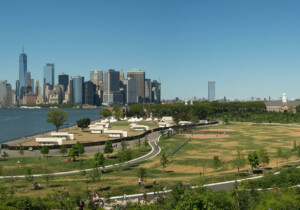After years of construction delays the St. Nicholas Greek Orthodox Church and National Shrine redesigned by Santiago Calatrava is open and aglow. Located adjacent to the World Trade Center site, the church and shrine was one of the Lower Manhattan structures destroyed on September 11th by the fall of Tower 2. Calatrava’s design for the religious building, unveiled in 2013, takes cues from Byzantine architecture, specifically the Hagia Sophia, the famous Greek Orthodox Church in Istanbul turned mosque turned museum turned back to mosque.
Over the last decade, the realization of the building has been riddled by construction delays and debacles. In the years following the 2001 attack, plans proposing an Islamic community center and mosque at the site surfaced and were met with protest. Later in 2014 a preemptive ground breaking stunted progress until The Greek Orthodox Archdiocese (GOA), which oversees the St. Nicholas Greek Orthodox Church, struck a formal leasing deal with the Port Authority for 99 years and in exchange was granted approval to construct the ecclesiastic structure at its original location. After the building topped off on its dome construction company Skanska withdrew from its contract after the GOA defaulted on payments. In 2020 under the oversight of a new board the Friends of St. Nicholas construction picked up again only to be held up mere weeks later by the onset of the pandemic. The project’s nearly two-decade long timeline totaled in at $57 million for design and construction costs alone.
Construction slowly progressed after kicking off in August 2020 and is now, sigh of relief, finally complete.
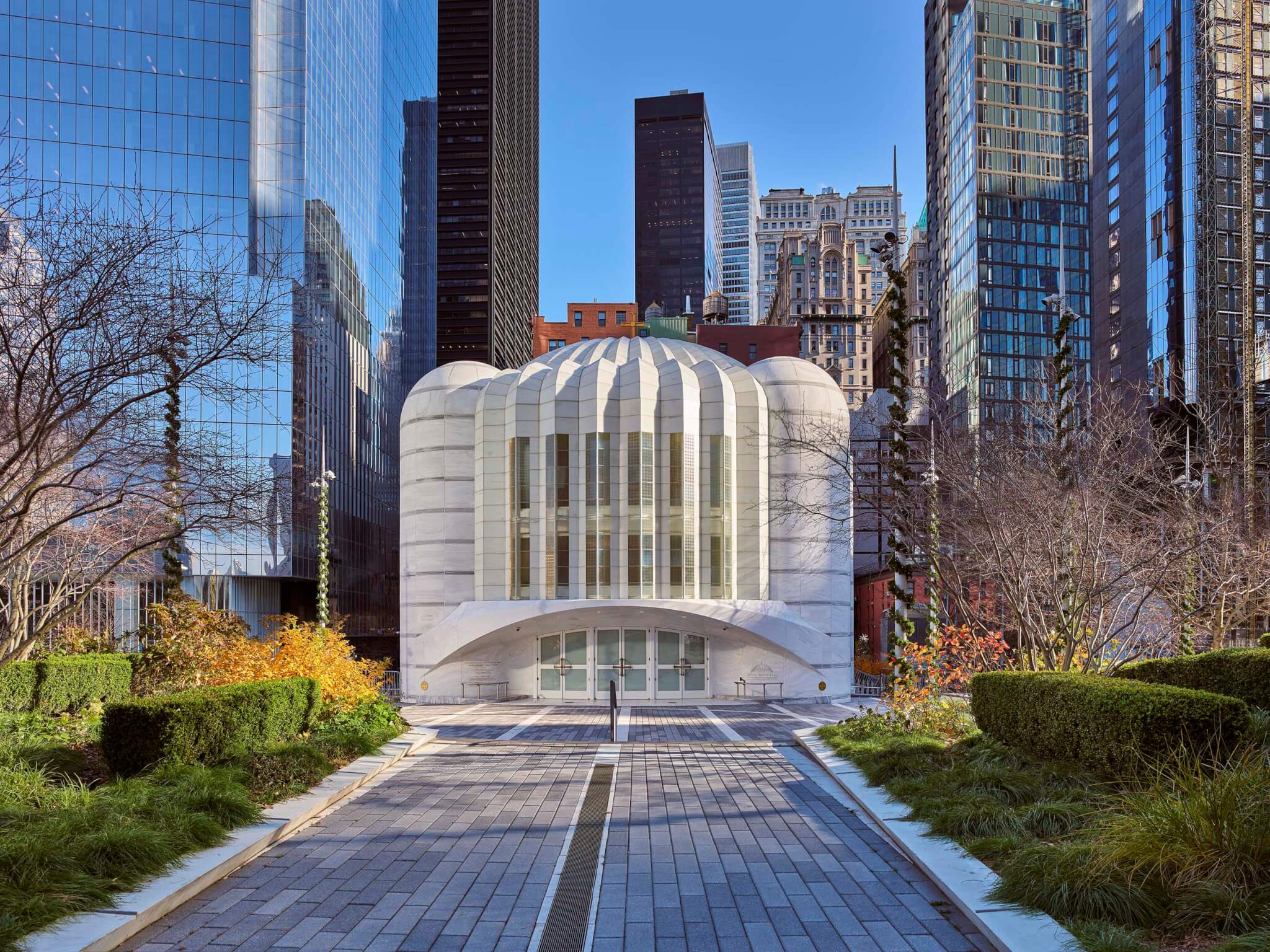
Calatrava’s design completely reimagines the building, giving an entirely new look and shape to what was once a simple row house established by Greek Orthodox leaders in 1916. When tasked with redesigning the structure Calatrava paid mind to the symbols and rites of Greek Orthodox practice while also considering the site’s connection to the World Trade Center Memorial. Calatrava also designed the nearby transportation hub at the World Trade Center, known as the Oculus.
“To see the St. Nicholas Greek Orthodox Church and National Shrine finally open is emblematic of Lower Manhattan’s storied future and defining past,” said Santiago Calatrava reflected in a statement.
“I hope to see this structure serve its purpose as a sanctuary for worship but also as a place for reflection on what the city endured and how it is moving forward. Architecture can have an intrinsic symbolic value, which is not written or expressed in a specific way but in an abstract and synthetic manner, sending a message and thus leaving a lasting legacy. Thank you to the Port Authority of New York and New Jersey, the Greek Orthodox Archdiocese of America, the Friends of St. Nicholas and the WTC Memorial Museum for their fervent support throughout the course of reconstruction and for believing in my architectural vision.”
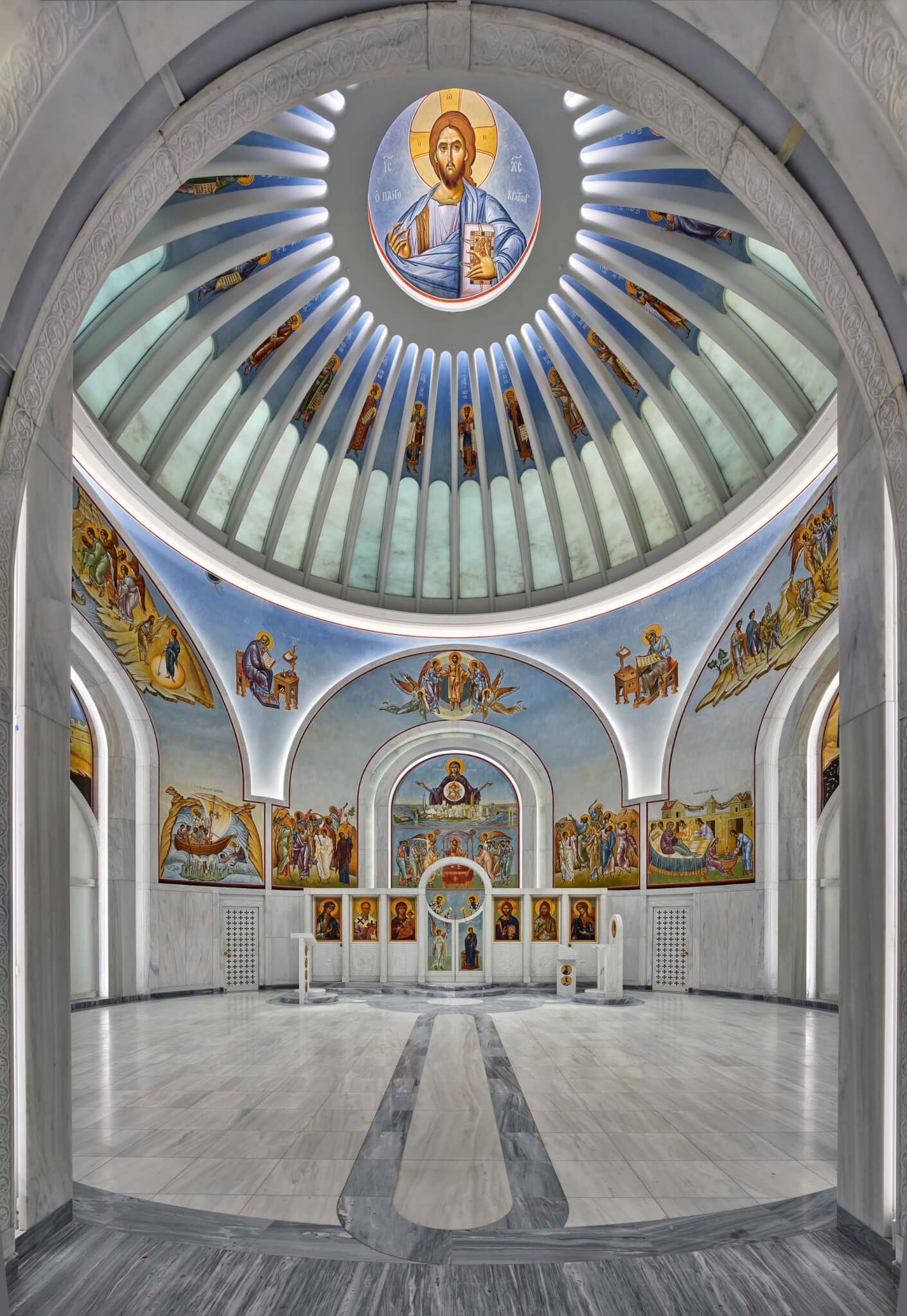
As previously mentioned the church design was deeply influenced by Byzantine architecture, namely the intricate mosaic works adorning the Hagia Sophia, which are referenced in the new domed construction. The church’s exterior is completely wrapped with Pentelic marble, the same material used on the Parthenon in Athens.
Its most recognizable feature, and perhaps most obvious nod to the renowned Turkish mosque is its dome, which has been fashioned with 40 window and 40 “ribs,” the same number as the Hagia Sophia. On the underside of St. Nicholas’s dome are depictions of Jesus Christ and twenty Old Testament prophets. The dome itself has been constructed using a thin stone and backlit glass panels.
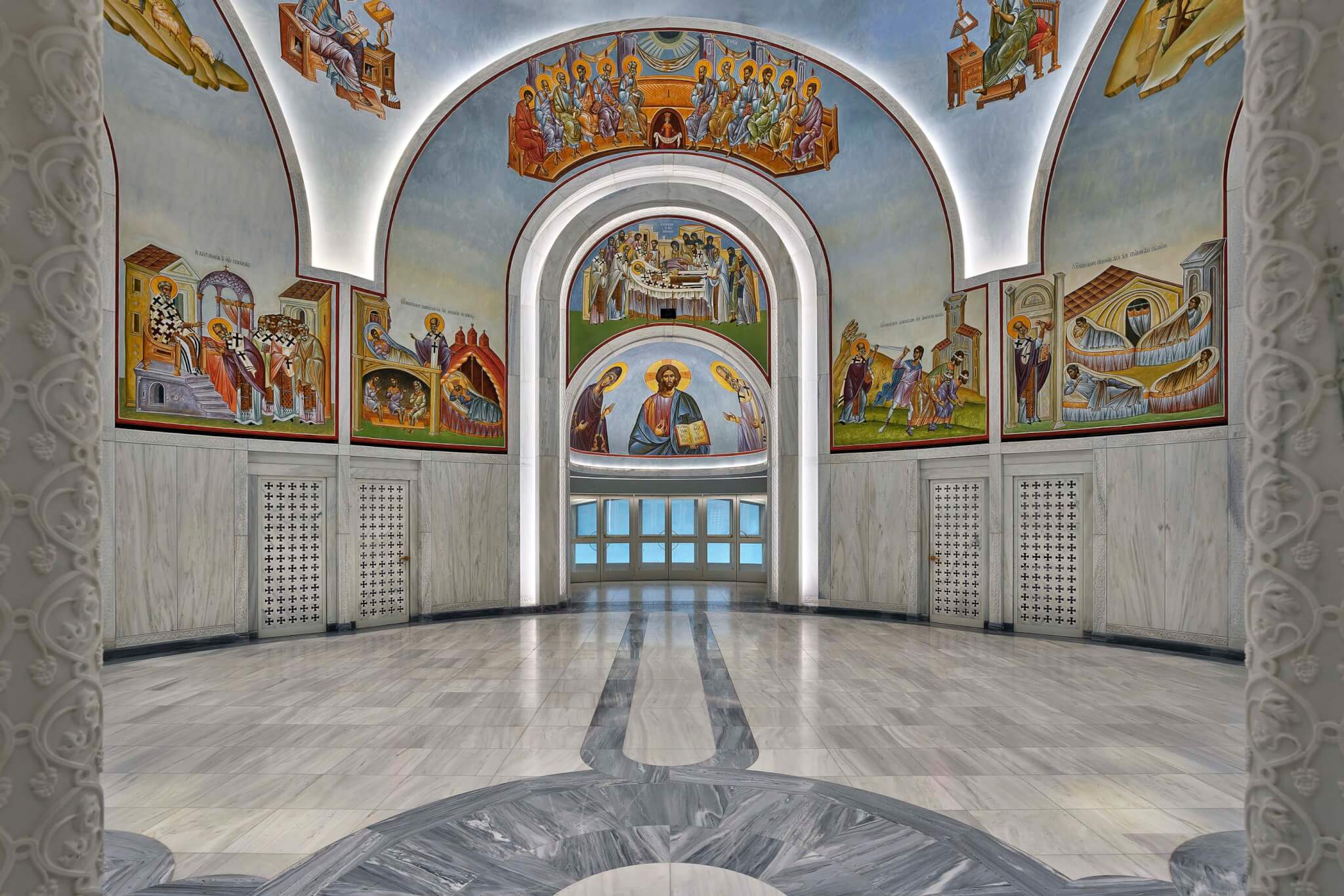
On the outside two rounded towers stand prominently, their gray and white striping, is a nod to the Byzantine decoration used on the Church of the Holy Savior in Chora, Turkey. Above the church’s entrance the ribbing of the dome is replicated and drapes down into a series of narrow windows. When viewing the church’s back one can clearly see the full cylindrical shape of the dome.
Inside the church directly adjacent to its porticus are two candle rooms housed within the rounded columns. A set of doors in the porticus open up to the exonarthex, narthex, and eventually the nave, or the main altar. Access to the altar is shield by the “Royal Doors” painted to depict the Annunciation, the story in which the Virgin Mary receives word she will bear a son.
Recesses on the north and south locations of the structure feature arched windows faced with mullions in the shape of a cross. Within the church the walls and ceiling are covered with bright paintings that depict Biblical stories. They were planned by Bishop Joachim of Amissos, an expert scholar on Byzantine iconography, and hand painted by Father Loukas, a priest-monk from the Monastery of Xenonphontos on Mt. Athos in Greece.
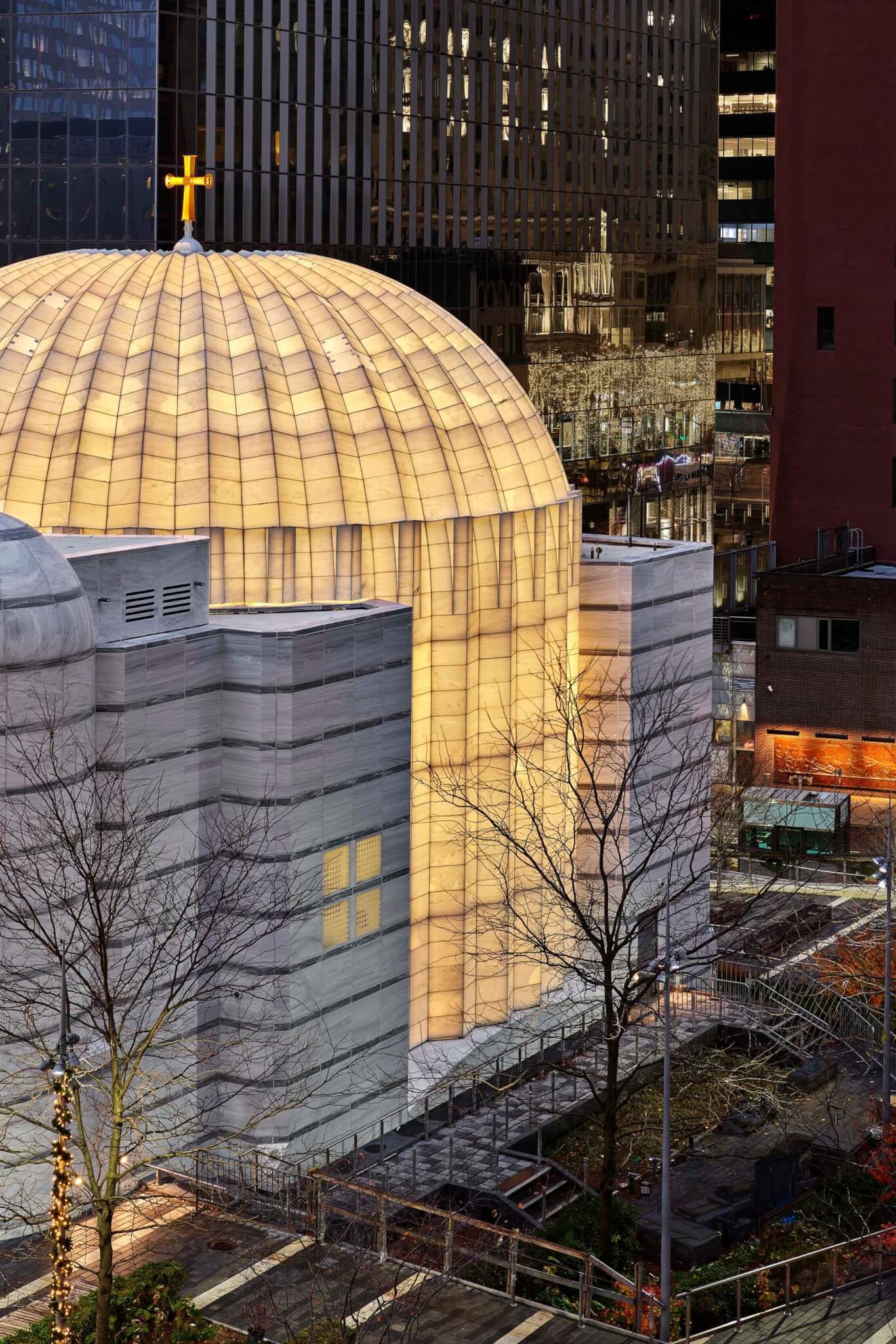
Equally as important to the design as the paintings is its lighting, Calatrava worked with DLR Group on the lighting design to craft the church as a place that truly glows from within, especially at night. The solid stone’s transparent appearance lets natural light, artificial light, and candlelight beam inside and out.
In addition to a place of prayer, the small church also houses community rooms and offices on its second and third floors. It envisions these spaces being used by the community for meetings or other activities. Also in the purview of the site’s master plan revitalization was the adjacent Liberty Park, opened in 2016, as well as the 9/11 Memorial & Museum.
“This Shrine will be a place for everyone who comes to the Sacred Ground at the World Trade Center, a place for them to imagine and envision a world where mercy is inevitable, reconciliation is desirable, and forgiveness is possible,” said His Eminence Archbishop Elpidophoros of America. “We will stand here for the centuries to come, as a light on the hill, a shining beacon to the world of what is possible in the human spirit, if we will only allow our light to shine before all people, as the light of this Shrine for the Nation will illuminate every night sky to come in our magnificent City.”










